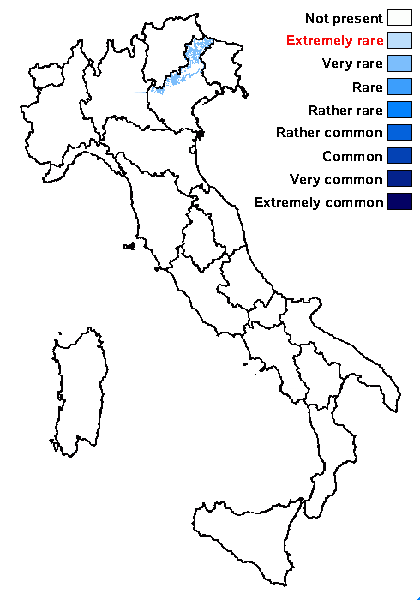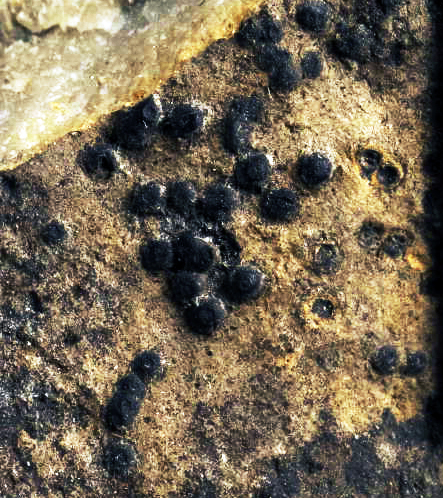Polyblastia rivalis (Arnold) Zschacke
Hedwigia, 55: 293, 1914.. Basionym: Thelidium rivale Arnold - Verh. zool.-bot. Ges. Wien, 21: 1114, 1871.
Synonyms:
Distribution: N - Ven (Dalla Torre & Sarnthein 1902).
Description: Thallus crustose, partly endosubstratic, grey-white to yellowish grey. Perithecia black, globose to pear-shaped, 0.4-0.6 mm across (in section), immersed in at base into pits in the rock, projecting with the upper third, with a depressed apical region. Involucrellum thick, limited to the upper third of the perithecium, slightly diverging from exciple in lower part; exciple brown-black throughout; hamathecium of periphyses and periphysoids, interascal filaments absent; hymenial gel hemiamyloid, I+ red (I+ blue at very low concentrations of I), K/I+ blue. Asci 8-spored, clavate, K/I-, fissitunicate, the wall thickened above, with an ocular chamber, dehiscent by extrusion of an endotunica to form a delicate rostrum. Ascospores submuriform, with 3-6 transverse septa and (partly) a single, incomplete longitudinal septum, hyaline, ellipsoid, often pointed at one end, 48-76 x 18-30 μm. Photobiont chlorococcoid. Spot tests: K-, C-, KC-, P-, UV-. Chemistry: without lichen substances.Note: on periodically inundated limestone or calcareous schists; only known from the Eastern Alps (Austria) but likely to occur elsewhere in the Alps; to be looked for in the Italian Alps.
Growth form: Crustose
Substrata: rocks
Photobiont: green algae other than Trentepohlia
Reproductive strategy: mainly sexual
Periodically submerged (e.g. in creeks)
Commonnes-rarity: (info)
Alpine belt: absent
Subalpine belt: very rare
Oromediterranean belt: absent
Montane belt: very rare
Submediterranean belt: absent
Padanian area: absent
Humid submediterranean belt: absent
Humid mediterranean belt: absent
Dry mediterranean belt: absent

Predictive model
Herbarium samples
Growth form: Crustose
Substrata: rocks
Photobiont: green algae other than Trentepohlia
Reproductive strategy: mainly sexual
Periodically submerged (e.g. in creeks)
Commonnes-rarity: (info)
Alpine belt: absent
Subalpine belt: very rare
Oromediterranean belt: absent
Montane belt: very rare
Submediterranean belt: absent
Padanian area: absent
Humid submediterranean belt: absent
Humid mediterranean belt: absent
Dry mediterranean belt: absent

Predictive model
| Herbarium samples |
 Index Fungorum
Index Fungorum
 GBIF
GBIF




